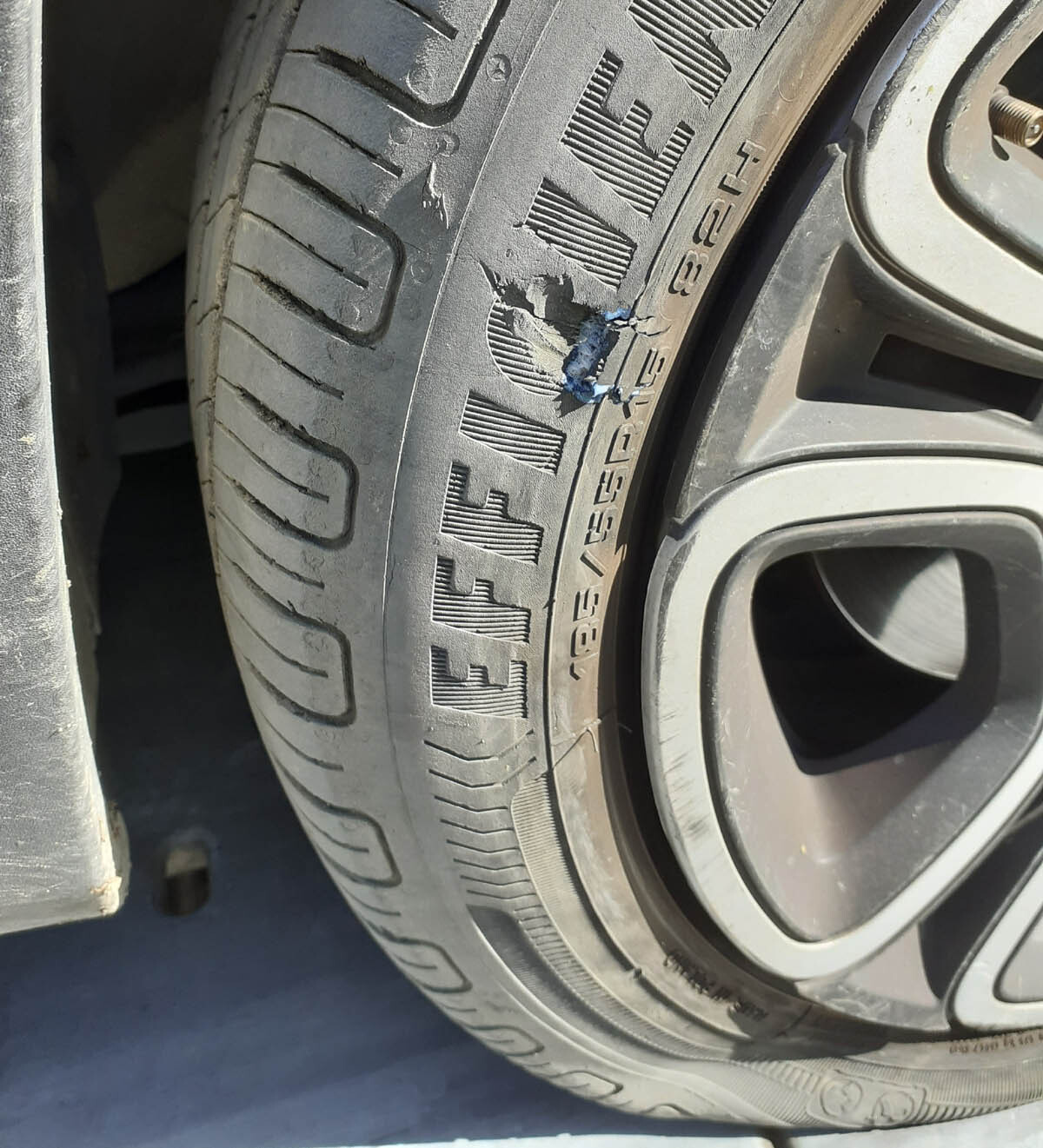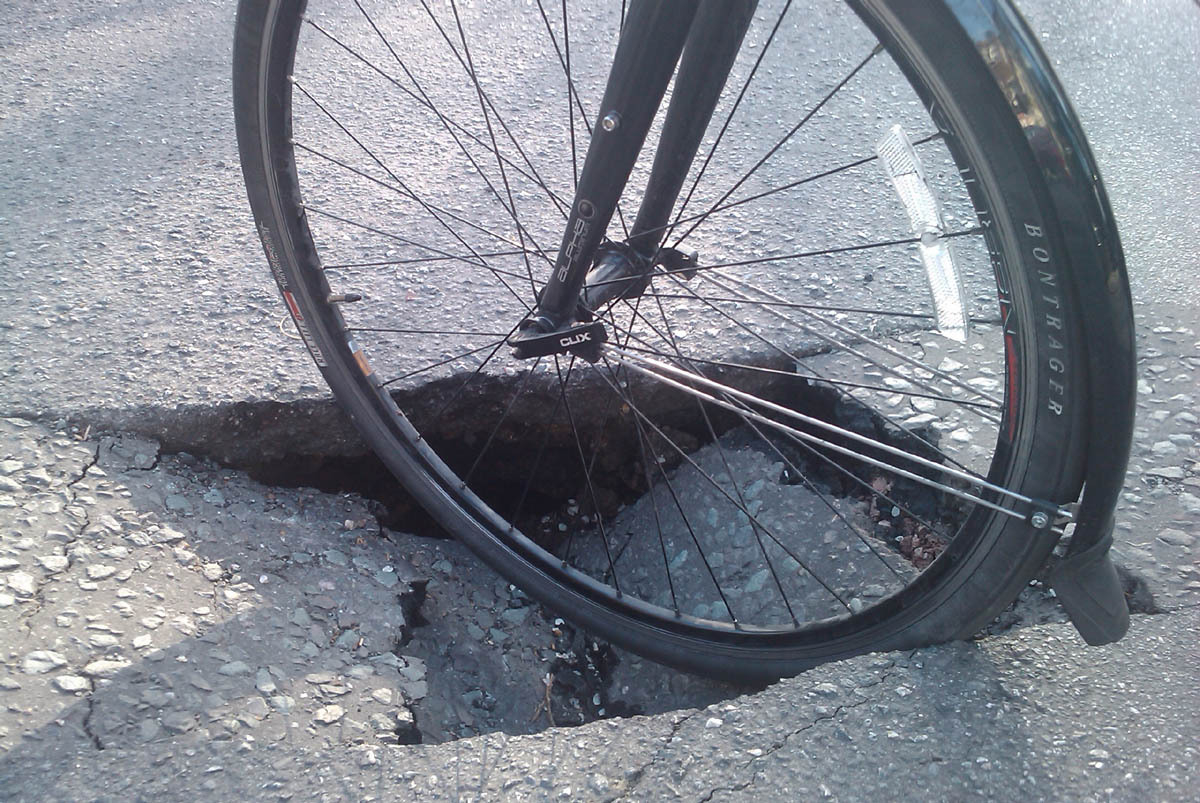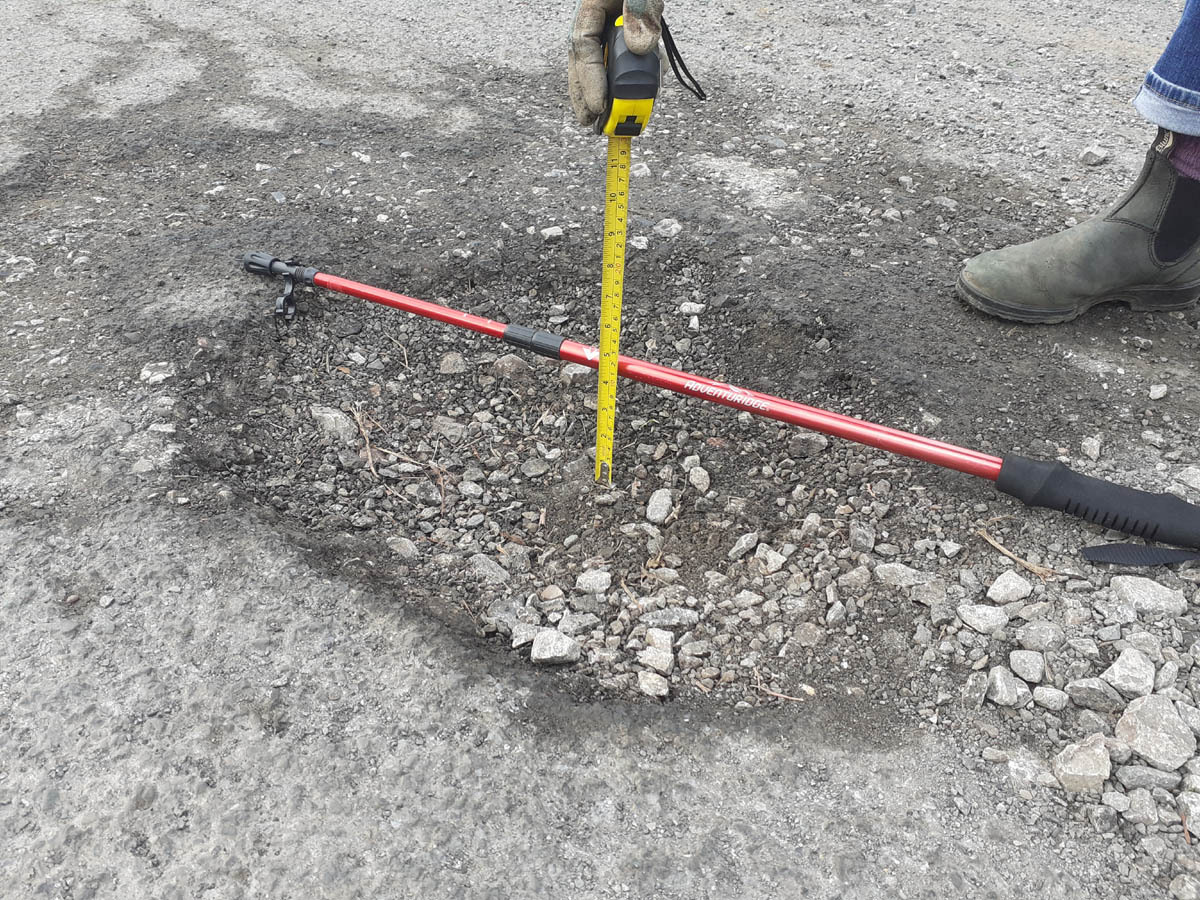
Then and now
Bang, crash, rattle as the bus lumbers along a road full of potholes, badly patched sections and ‘oozing’ tarmac distorted by the weight of passing heavy vehicles… A familiar story? But that was in 1969, when I was a student in Spain: at the time, a country almost ‘third world’ in terms of its rife poverty, under-investment and crumbling infrastructure ‒ and indeed, regarded by many as a pariah state, still crippled by the dictatorship of Francisco Franco. Fifty-five years later, I am experiencing the same noisy, bone-rattling sensations whenever I drive on our local roads in South Devon.
Potholes galore
Things are so bad now that we all love to hate potholes; they rival the weather as the most popular topic of conversation – and that’s saying something, given that we have had double the normal amount of rain for this time of year; and yes, there is a connection, as we’ll see later! Potholes may have become a favourite topic for cartoons and comedians, but they are no laughing matter. Like so many drivers, I’ve had some bad experiences of actual potholes: so often I’ve hit a pothole hard, not having seen it in traffic, or thinking it was a shallow puddle. So far, I’ve been lucky, but I’m almost afraid to drive my other car, which has low-profile tyres.
A381 – our bone-shaker road
The A381 from Totnes to Newton Abbot used to be awful, and still has many potholes, but at last some sections are receiving long-overdue remedial work. Recently I used the same road, but in the other direction. It is dreadful… not just riddled with potholes, but with long stretches where badly (cheaply?) re-surfaced sections of road have ‘de-laminated’: the top layer of tarmac has peeled off – evidence of shoddy resurfacing, where the new surface hasn’t bonded properly with the layer underneath. Other long sections were apparently once treated (even more cheaply) to ‘surface-dressing’ with tar and chippings, but large areas are now denuded of both.
The family ‘bus’, our ageing MPV, with its quite soft suspension and high tyre-walls, used to soak up road-surface imperfections comfortably, but the roads are so bad now that it bangs and crashes along, to the extent that the driver’s door is now going to need its top hinge welded up ‒ for the third time ‒ as a result of being shaken about so much. Interestingly, the same problem is being reported on social media by owners of this model (and its other ‘Eurovan’ counterparts) up and down the country: the vehicles are literally being shaken to bits on UK roads!
Where did our wheel go?
My wife’s car, a small 4×4, lost its front nearside wheel 18 months ago, for no obvious reason, but almost certainly having been shaken loose by repeatedly hitting potholes. I was driving at the time, and it was absolutely terrifying trying to steer the car on three wheels, almost losing control: I only just avoided skidding into the path of oncoming traffic. We were lucky. Doubly so, because a passing cyclist pointed out where the wheel had ended up in the roadside vegetation.
At around the same time one of our sons lost a tyre to a series of potholes near Dartington. More recently, a friend lost a tyre to a pothole-puncture while taking her son to a football match. Another friend lost two new tyres in a few days: a brand-new tyre fitted just a couple of days previously to replace one fitted a few days before that! I heard that the same tyre has just had to be replaced yet again!
Several of these ‘pothole-victims’ were front nearside tyres, damaged by the crumbling edges of local roads. A local Facebook page had a photo of three cars pulled into the side of the road near Riverford Bridge on the A384, with an RAC van and an AA van in attendance: all three had suffered pothole punctures in quick succession at the same spot. And so it goes on: warnings about new potholes, and complaints about tyres and wheels being damaged, are almost a daily feature of our town’s Facebook forum.
Pothole humour
For some years, the A381 from Totnes to Newton Abbot was the subject of much local humour. Driving this road meant negotiating a veritable chicane several miles long. You could always tell whether a driver following you was a local or a grockle; if the latter, it would take them a while to realise why other cars were weaving around – to avoid potholes ‒ and they would begin to follow the same trajectory. Locals agreed that the correct reaction if you were stopped by the police and confronted with a breathalyser test, was to blame the potholes for your erratic driving. On one occasion a police car behind me actually followed my line around the worst potholes!
Potholes have been the theme of many cartoons and humorous images (both photoshopped and genuine) in the press and social media, including television and newspaper reports of a phantom ‘pothole Banksy’ in Daventry, Northants. This individual puts up posters around the town; for example, one which reads: “Welcome to pothole city, home of the incompetent council”. In the tv report, a local resident told the BBC: “Some of our roads are more hole than road!” Potholes really are getting to be beyond a joke!
Where do potholes come from?
Potholes are the obvious consequence of poor maintenance, and failure to replace road surfaces as often as necessary – the result of ‘austerity’ and reduced road-repair budgets. Inevitably, the increased size and weight of goods vehicles is a factor causing damage to the road surfaces, but cars are also now considerably larger than they were, and heavier ‒ particularly electric cars. Most roads (and indeed bridges and multi-storey car parks!) built decades ago were not designed to take such punishment. Country lanes generally don’t have to cope with heavy lorries, but now they too are suffering attrition from carrying these weightier private cars.
Of course, as hinted above, the increasingly wet weather is a major factor contributing to this unacceptable situation; many potholes result from a weakness in the road surface or in the underlying structure, which is exploited by rainwater (water always finds its level), thus undermining the road surface itself and producing a small area of subsidence. The subsidence becomes a pothole which grows as hundreds of vehicles bang into it, often with a tell-tale of area of gravel or sand thrown up by passing tyres. I have seen evidence of increased delamination on motorways, too, (especially on the M4 eastbound from Bristol), along with rising numbers of actual potholes.
The consequences

The pothole problem is leading to so many complaints and damage claims against road authorities that repairs are being carried out, but so slowly that the process is like painting the Forth Bridge. All too often, temporary repairs don’t last: the potholes soon open up again. I fear for the safety of motorcyclists and cyclists; two motorcyclists I spoke to described having constantly to keep a watchful eye out for potholes, and to steer round them. The gravel and debris emanating from a pothole can cause a dangerous skid. I have also heard that a cyclist riding out with a local cycling group hit a pothole and crashed, smashing several bones in his hand. I would advise anyone on two wheels to keep away from the main roundabout in Totnes, which has ruts where two or three lines of tarmac are crumbling at the edges; it pulls my MPV all over the place, and I would not risk it on my bike. Motorists tend not to be very tolerant when cyclists swerve away from the edge of the road to avoid potholes, crumbled road-edges or skid-provoking gravel. The same dangers and challenges are faced by horse-riders, anxious to avoid a hazardous stumble which might result in injury.

Tyred of all this?
Staff at our local tyre depot say the number of customers coming in with split tyres or damaged wheels has been rising: now they have an average of two a week suffering from pothole damage. Tyres with split or damaged sidewalls cannot be repaired, and have to be replaced. Decent tyres can cost over £100 each, even for an average family saloon. The tyre depot often also has to deal with damaged wheels; a new wheel can cost several hundred pounds. When I called in to speak to them, I was shown a bent wheel; an ‘original equipment’ replacement from the manufacturer would have cost over £500; they said a damaged wheel on a Volkswagen cost over £1000 to replace. Clearly these incidents are costing motorists a small fortune, and all in the midst of a cost-of-living crisis!
On 19 March 2024 the online magazine of the RAC reported the fact that the Asphalt Industry Alliance (AIA) considers that roads in England and Wales are at ‘breaking point’ due to potholes, and that more than half of the local road network could fail in the next 15 years. The sum needed to fix the backlog of repairs stands at a record high of £16.3bn, and in the current financial year local authorities are expected to fix more than two million potholes.
It seems that currently, only 47 per cent of local roads are in ‘good structural condition’ and over 107,000 miles of local roads have less than 15 years’ structural life left in them. Meanwhile, 34,000 miles of roads are categorised as ‘structurally poor’; I could name a few in South Devon! Pothole victims are now able to use What3Words to report potholes, and councils are using this to locate those reported.
The government has promised to divert cash from HS2 into road repairs, but what about our road fund licence, which is about to increase yet again? It seems that paying for repairs to tyres and wheels is a new tax on motorists. As one of the motorcyclists I spoke to suggested, one gets the impression that the government is trying actively to discourage taxpayers from using the roads.

Claims?
Unsurprisingly, advice and information is now being given to motorists on how to claim for repairs to damage caused by potholes. On 18 March 2024 the Bristol Post suggested “How to make a claim for pothole damage”, and reported that road safety specialists are warning drivers to be on the lookout for dangerous potholes. Council budgets for compensation are said to have fallen by more than a half, and potholes across the country are remaining “unrepaired for months at a time”. To be eligible for compensation, there are rules about how deep a pothole has to be, and how long it remains before being repaired. To support a claim, drivers should all carry a tape measure, and a camera or mobile phone – ideally one which will record time and date – to take photos. Actually, you need to have a mobile phone anyway to contact your breakdown service when one of your tyres falls victim to a pothole, because…
Spare? Oops…
Most modern cars no longer carry even a skinny spare wheel. Instead, to save weight and cost, cars are equipped with a puncture repair kit, which includes a tyre inflator that pumps repair fluid into the tyre. The theory is that the fluid will seek out the puncture and seal it… you hope. When the tyre of a car we hired for a holiday was split by a rock on a rough track, the tear in the sidewall simply allowed the fluid to ooze out. The car was therefore unusable and had to be trailered away. Had it been my own car, my ego (and bank balance!) would have been as deflated as the tyre. Fortunately, the car hire company quickly provided a replacement.
The end of the road for Broken Britain?
So, where does that leave the UK in 2024? Potholes in the road seem to be symbolic of the potholes in the country in general. Our roads will take years to be returned to acceptable standards, and the same is true of so many of our institutions and services. There is much to be said about this – in fact, enough for another article to follow this one. Living in the UK seems to be typified by travelling along a badly maintained road: drive with your eyes wide open, avoiding the potholes, looking after yourself and your wheels, thinking about what you are doing, and focusing on arriving safely at your destination: hopefully, one day, a more civilized and caring society. Roll on the General Election: vote wisely!
